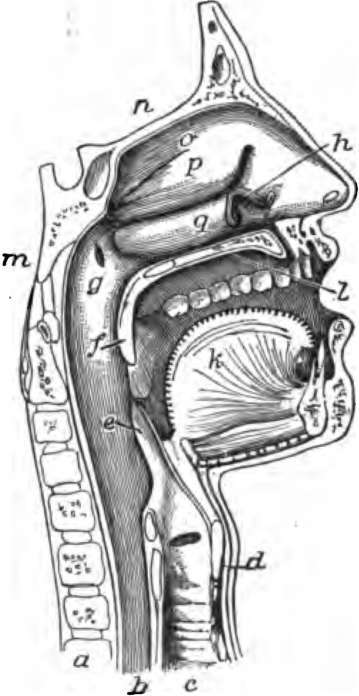The Mouth Cavity
Description
This section is from the book "The Human Body: An Elementary Text-Book Of Anatomy, Physiology, And Hygiene", by H. Newell Martin. Also available from Amazon: The Human Body.
The Mouth Cavity
(Fig. 41) is bounded in front and on the sides by the lips and cheeks, below by the tongue, k, and above by the palate, which latter consists of an anterior part, l, supported by bone and called the hard palate, and a posterior, f, containing no bone, and called the soft palate. The two can readily be distinguished by applying the tip of the tongue to the roof of the mouth and drawing it backwards. The hard palate forms the partition between the mouth and nose. The soft palate arches down at the back of the mouth, hanging like a curtain between it and the pharynx, as can be seen on holding the mouth open in front of a looking-glass. From the middle of its free border a conical process, the uvula, hangs down.
What is the isthmus of the fauces? Where does the gullet begin? Through what regions of the body does it pass? Where does the stomach lie? What part of the alimentary canal succeeds the stomach? Describe it briefly. How does it end? How does the large intestine differ from the small? How does it end?

Fig. 41. The mouth, nose and pharynx, with the commencement of the gullet and larynx, as exposed by a section, a little to the left of the median plane of the head, a, vertebral column ; b, gullet; c, windpipe ; d, larynx; e, epiglottis; f, soft palate; g, opening of Eustachian tube; k, tongue; l, hard palate; m, the sphenoid bone on the base of the skull; n, the fore part of the cranial cavity; o, p, q, the turbinate bones of the outer side of the left nostril chamber.
What are the boundaries of the mouth cavity? Of what parte does the palate consist?
The Teeth
Immediately within the cheeks and lips are two semicircles, formed by the borders of the upper and lower jaw-bones, which are covered by the gums, except at intervals along their edges where they contain sockets in which teeth are implanted. During life two sets of teeth are developed : the first or milk set appear soon after birth and are shed during childhood, when the second or permanent set appear.
The General Structure Of A Tooth
The teeth differ in minor points from one another, but in all, three parts are distinguishable ;* one, seen in the mouth, and called the crown of the tooth; a second, imbedded in the jaw-bone, and called the root or fang; and between the two, embraced by the edge of the gum, a narrowed portion, the neck or cervix. By differences in their forms and uses the teeth are divided into incisors, canines, bicuspids, and molars, arranged in a definite order in each jaw. Beginning at the middle line we meet in each half of each jaw, successively, with two incisors, one canine, and two molars in the milk set; making twenty altogether in the two jaws. The teeth of the permanent set are thirty-two in number, eight in each half of each jaw, viz.—beginning at the middle line—two incisors, one canine, two bicuspids, and three molars. The bicuspids of the permanent set replace the molars of the milk set, while the permanent molars are new teeth added on as the jaw grows, and not substituting any of the milk teeth. The hindmost permanent molars are often called the wisdom- teeth.
How can we feel the difference between them ? What cavities does the hard palate separate? Where does the soft palate lie? What is the uvula ?
What do we find inside the lips? Where are the gums? What do the margins of the jaw bones contain ? What are the milk teeth ? What the permanent ?
What parts may we distinguish in every tooth? Into what groups are teeth divided ? Why ?
* A. number of teeth can be readily obtained from a dentist, and will be found or great use in connection with this lesson.
Continue to:
